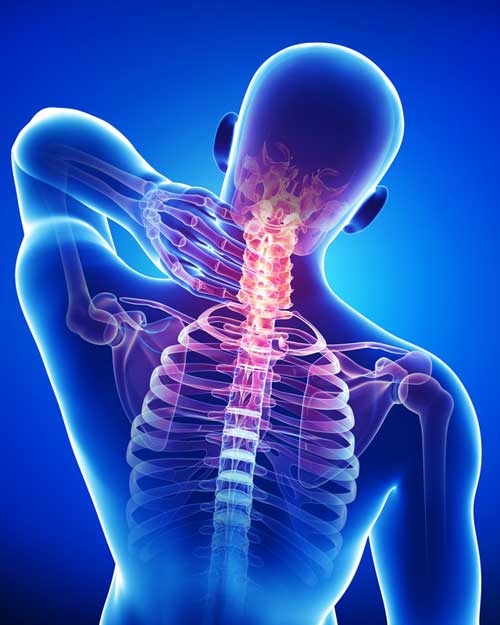
Neck & Mid Back Pain
Neck pain is discomfort, pain (dull and sharp) or tightness occurring from the shoulder and up to your skull.
Symptoms include:
- Stiffness
- Muscle spasm
- Muscle ache
- Nerve pain – sharp electric shooting pain
- Headaches
- Reduced range of motion – difficulty turning head to look over shoulder, bending or looking up and down.
Neck pain can even cause pressure or a burning sensation down your arms and hands. Quite often, “tennis elbow” or lateral epicondylitis has a component that stems from compression in the neck or upper thoracic spine.
You neck is made up of several structures: bones, muscles, ligaments, tendons, nerves, lymphatics. You have seven cervical vertebrae that stack up on top of each other. Between each one there is a cartilage disc or shock absorber. Spinal nerves exit through the gaps between each of these vertebrae. The nerves activate and send signals to your muscles to make them move. The neck is designed to support your head and allow movement. Any abnormalities, inflammation or injury can cause neck pain and stiffness.
The most common cause of neck pain is muscle stiffness and inappropriate posture. Extensive sitting at the computer, for instance, usually results in some sort of neck problems along the way.
Some other causes are:
- Whiplash and motor vehicle accidents. Sudden application of the vehicle’s brakes causes a whip-like movement of the body and forces the neck into a position it would not normally be in. This can upset neck alignment or even cause damage to the ligaments that support the neck. It can be a severe injury with long-lasting detrimental effects. However, acupuncture and massage are beneficial treatments to alleviate the results of this type of injury.
- Muscle strain: physical activity, repetitive strain, lack of use, even falling asleep in an awkward position on the couch.
- Degenerative disc disease
- Herniated disc
- Osteoarthritis
- Compression e.g. head stand in yoga
Acupuncture and massage are an effective way to get pain relief from neck disharmonies. It includes taking a detailed medical history and a physical exam. Most often there are various “trigger points” or tight bands of muscles in the upper back. These points relate to the pain and limited movement of the neck. Acupuncture utilizes these “active” trigger points for the insertion of needles to release the muscle spindles and return muscles to their normal length. It also helps free up agitated nerves and reduce inflammation. Acupuncture also treats the body holistically. Sometimes the cause of neck pain can come from other sources. For example, pressure coming from further down the thoracic spine can transfer up to the neck region. This needs to be addressed as well for there to be a positive result.
Mid and upper back pain (thoracic spine)
This section of the back suffers many of the same symptoms and causes for discomfort as for neck pain. An interesting factor here is that the chest can play a significant role. Tight or shortened pectoralis muscles (chest muscles) can pull the shoulder girdle anterior or forward. This places extra strain and pressure on the upper back muscles (trapezius, rhomboid, splenius capitis, erector spinae). The pain is often felt between the shoulder blades. It can then even travel up to the neck area. In this scenario it is important to address the tightness and disharmony in the chest as well as releasing and soothing the structures in the back.
Another dynamic component of the thoracic spine is the ribs. Ribs can also be problematic. Amazingly there are six points of contact or articulations with the ribs to the spine and the bone in your chest (sternum). The ribs need to be able to move freely to allow us to inhale by expanding the chest. They also protect organs in the upper torso – for example, the lungs, heart, pancreas and liver. If a rib is not in its correct position and cannot move properly, it will cause pain. Quite often there is a sharp pain between the shoulder blades. This can be accompanied by pain travelling across the ribs, sometimes even to the chest. Impact and trauma can cause the ribs to be mal positioned. Even a bad cough can sometimes cause rib displacement.
In these cases, it’s a matter of freeing up the spasm around the affected rib and vertebrae. Once the affected area has been identified, acupuncture is used on specific points to release the surrounding tissue. This helps alleviate the pain caused by the protective spasm and encourages the rib to return to its normal position and mobility. Combining acupuncture with remedial massage helps speed up the healing and corrective process.
